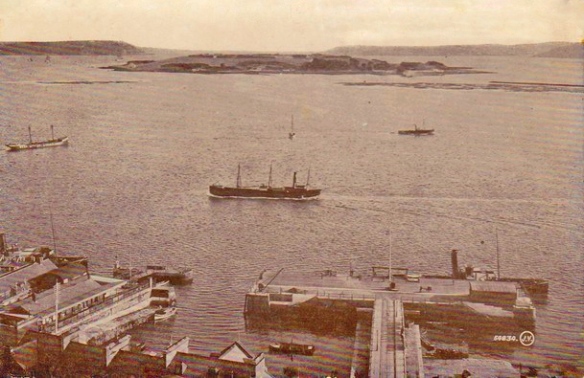
Cork Harbour from Cobh showing the Pier Head (foreground, right) and Spike Island in the distance.
The intriguing story of a 1924 attack on unarmed British soldiers in the Irish Treaty Port of Cobh
On Friday, 21st March 1924, at around 7.00pm a large yellow Rolls Royce touring car pulled up opposite the main landing jetty in Cobh, Co. Cork. Inside sat four men in the uniforms of the Irish Free State army. They watched as a passenger ferry operated by the British War Department, the Sir John Wyndham, pulled up at the jetty, known locally as the Pier Head, and a group of up to 50 unarmed British soldiers and a number of civilians disembarked from the vessel. Then, without warning, the men in the car produced two Lewis machine guns and began to fire on the soldiers on the pier. Up to 18 soldiers and a number of civilians fell, many of the soldiers were very seriously injured and one of them, Private Herbert Aspinall of the Royal Army Service Corps, died an hour later at Spike Island Military Hospital. The attack attracted widespread condemnation and started a major manhunt for the attackers and a search for their distinctive car.
The attack took place less than 18 months after the foundation of the Irish Free State which was founded under the Anglo-Irish Treaty which split the Irish Republican Army and led to a short but deadly Civil War. At the start of March 1924 a mutiny brook out in the Irish (Free State) army due to mass demoblisation of men while some while others in the army were unhappy that the Free State was not doing more to achieve the aims set down by Michael Collins who described the Treaty as a “stepping stone to the republic”.
Some believed that the Cobh attack was carried out by some of the disgruntled Free State solders but soon the focus shifted to the Anti-Treaty IRA which was on the losing side in the recent Civil war. The belief, echoed by the government of W.T. Cosgrave, is that the attack was designed to convince Britain that its forces, remaining in Southern Ireland under the 1922 Anglo Irish Treaty, were under attack from the Free State forces and that the IRA hoped a deadly reponse from the British might unite Anti-Treaty and disillusionedPro-treaty soldiers. Within days the Free State government issued a proclamation offering £10,000 (sterling) – almost €1,000,000 in today’s money – for information leading to the arrest of five Anti-Treaty IRA men named and declared guilty.
Author John Jefferies has researched this story over the last three years and has tracked down the trail of those blamed for the attack and looked at the related story of the yellow Rolls Royce, nicknamed “The Moon Car”. Where lies the truth in this story of intrigue? John’s book “Death on the Pier” is due out in Spring 2017.
